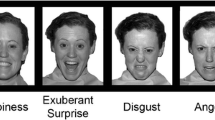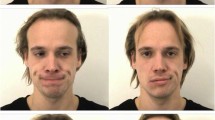Abstract
Substantial evidence has accrued indicating the involvement of neuromuscular circuits in covert information processing. The physiological systems impartingemotional tone to covert processing, however, are less well understood. Reviewed here are findings from a variety of methodologies which suggest that somatic patterns, particularly in the face, reflect moment by moment emotional reactions. These findings imply neuromuscular involvement in affect-laden information processing; less conclusive, though suggestive, are data indicating that the proprioceptive feedback from these phasic and specific patterns of response are integrated cortically and influence covert processing and overt responding.
Similar content being viewed by others
References
Allport, F. H.: Social Psychology, Cambridge, Houghton Mifflin, 1924.
Arnold, M. G.: Emotion and personality, Vol. II. Neurological and Physiological Aspects. New York, Columbia University Press, 1960.
Bell, C.: On the necessity of the sense of muscular action to the full exercise of the organs of the senses. Proc. R. Soo. Edinburgh, 1842, pp. 361–363.
Bernstein, N. A.: Sketches of Physiology of Locomotions and the Physiology of Activity. Moscow, Medicina, 1966.
Bickford, R. G., Jacobson, J. L. and Cody, D. T. R.: Nature of averaged evoked potentials to sound and other stimuli in man. Ann. N. Y. Acad. Sci.,112, 204–218, 1964.
Bills, A. G.: The influence of muscular tension on the efficiency of mental work. Am. J. Psychol.38, 227–251, 1927.
Bull, N: The attitude theory of emotion. New York: Nervous and Mental Disease Monographs, 1951. No. 81.
Cacioppo, J. T.: The effects of exogenous changes in heart rate on facilitation of thought and resistance to persuasion. J. Person. Soc. Psychol.,37, 487–496, 1979.
Cacioppo, J. T., Harkins, S. G. and Petty, R. E.: The cognitive responses to persuasive appeals.In Petty, R. E., Ostrom, T. M., Brock, T. C. (eds.), Cognitive Responses in Persuasion. Hillsdale, Lawrence Erlbaum and Assoc., Publishers, in press.
Cacioppo, J. T., and Petty, R. E.: Attitudes and cognitive response: An electrophysiological approach. J. Person. Soc. Psychol., in press-a.
Cacioppo, J. T., and Petty, R. E.: Electromyographic specificity during covert information processing. Psychophysiology, in press-b.
Cacioppo, J. T., and Petty, R. E.: Lip and nonpreferred forearm EMG activity as a function of orienting task. J. Biol. Psychol., in press-c.
Cacioppo, J. T., Petty, R. E., and Snyder, C. W.: Cognitive and affective response as a function of relative hemispheric involvement. Internat. J. Neurosci.,9, 81–89, 1979.
Cacioppo, J. T., Petty, R. E., Snyder, C. W., Braccio, M. K., Calibrese, M. and Quintanar, L.: Electrophysiological concomitants of the depth of processing dimension. Paper presented at the annual meeting of the American Association for the Advancement of Science, Houston, January, 1979.
Cannon, W. B.: Bodily Changes in Pain, Hunger, Fear and Rage, rev. ed. New York, Appleton-Century-Crofts, 1929.
Cialdini, R. B., Levy, A., Herman, C. P., Kozlowski, L. T., and Petty, R. E.: Elastic Shifts of opinion: Determinants of direction and durability. Person. Soc. Psychol.34, 663–672, 1976.
Darwin, C.: The Expression of the Emotions in Man and Animals. London, John Murray, 1904. (First ed., 1872).
Davis, R. C.: The specificity of facial expressions. J. Gen. Psychol.10, 42–58, 1934.
Davis, R. C.: Patterns of muscular activity during “mental work” and their constancy. J. Exp. Psychol.24, 451–465, 1939.
Dunlap, K.: A System of Psychology. New York, Scribner’s, 1912.
Eibl-Eibesfeldt, I.: Similarities and differences between cultures in expressive movements.In Hinde, R. A. (eds.), Nonverbal Communication. Cambridge, Cambridge University Press, 1972, pp. 20–33.
Ekman, P. and Friesen, W. V. Unmasking the Face. Englewood Cliffs, Prentice-Hall, 1975.
Ekman, P., Friesen, W. V. and Tomkins, S. S. Facial affect scoring technique: A first validity study. Semiotica1, 37–53, 1971.
Faaborg-Anderson, K. and Edfeldt, A. W.: Electromyography of intrinsic and extrinsic laryngeal muscles during silent speech: Correlation with reading activity. Acta Otolaryngologica49, 478–482, 1958.
Feleky, A. M.: Feelings and Emotions. New York, Pioneer Press, 1924.
Frois-Wittmann, J.: The judgment of facial expression. J. Exp. Psychol.13, 113–151, 1930.
Fulcher, J. S.: “Voluntary” facial expression in blind and seeing children. Arch. Psychol.272, 5–49, 1942.
Gates, G. S.: An experimental study of the growth of social perception. J. Educat. Psychol.14(3), 449–461, 1923.
Gates, G. S.: A test for ability to interpret facial expressions. Psychol. Bull.22, 120, 1925.
Gellhorn, E.: Motion and emotion: The role of proprioception in the physiology and pathology of the emotions. Psychol. Rev.71, 457–472, 1964.
Haggard, E. A. and Issacs, F. S.: Micromomentary facial expressions as indicators of ego mechanisms in psychotherapy.In Gottschalk, C. A. and Averback, A. (eds.), Methods of Research in Psychotherapy. New York, Appleton-Century-Crofts, 1966, pp. 154–165.
Hanawalt, N. G.: The role of the upper and lower parts of the face as a basis for judging facial expressions: II. In posed expressions and “candid camera” pictures. J. Gen. Psychol.31, 23–36, 1944.
Hardyck, C. D. and Petrinovich, L. F.: Subvocal speech and comprehension level as a function of the difficulty level of reading material. J. Verb. Learn Verb. Behav.9, 647–652, 1970.
Izard, C. E.: The Face of Emotion. New York, Appleton-Century-Crofts, 1971.
Izard, C. E.: Human Emotions. New York, Plenum Press, 1976.
Jacobson, E.: Action currents from muscular contractions during conscious processes. Science66, 403, 1927.
Jacobson, E.: Electrical measurements of neuromuscular states during mental activities. IV. Evidence of contraction of specific muscles during imagination. Am. J. Physiol.95, 703–712, 1930.
Jacobsoh, E.: Electrophysiology of mental activities. Am. J. Physiol.44, 677–694, 1932.
Jacobson, E.: Biology of Emotions. Springfield, Charles C Thomas, 1967.
James, W.: What is emotion? Mind,9, 188–204, 1884.
Janis, I. L. and Mann, L. Decision Making: A Psychological Analysis of Conflict, Choice, and Commitment. New York, The Free Press, 1977.
Landis, C.: Studies of emotional reactions: I. A. preliminary study of facial expression. J. Exp. Psychol.7, 325–341, 1924(a).
Landis, C.: Studies of emotional expression: II. General behavior and facial expression. J. Comp. Psychol.4, 447–498, 1924(b).
Lange, C.: The Emotions. Denmark, 1885. (Original reference unavailable. Translated by Kurella, H., Leipzig: Theodor Thomas, 1887: retranslated by Istar Haupt, I. A. for Dunlap, E. (ed.), The Emotions. Baltimore, Williams & Wilkens, 1922).
McGuigan, F. J.: External auditory feedback from covert oral behavior during silent reading. Psychonom. Sci.25, 212–214, 1971.
McGuigan, F. J.: Cognitive Psychophysiology: Principles of Covert Behavior. New York, Appleton-Century-Crofts, 1978.
McGuigan, F. J. and Boness, D. J.: What happens between an external stimulus and an overt response? A study of covert responses. Pavlov. J. Biol. Sci.10, 112–119, 1975.
McGuigan, F. J. and Winstead, Jr., C. L.: Discriminative relationship between covert oral behavior and the phonemic system in internal information processing. J. Exp. Psychol.103, 885–890, 1974.
Mittenecker, E.: Die Variation von Lernund Verstarkungsbedingungen bei der eindrucksmassigen Beurteilung von Personlichkeitsmerkmalen. Bericht uber den 22. Kongress der Deutschen Besellschaft fur Psychologie, Gottingen, 1960, Cited by Izard, C. E., The Face of Emotion. New York, Appleton-Century-Crofts, 1971.
Müller, J.: Physiologie des Menschen. Vol. 2. Koblenz, 1840, cited by Peiper, A., Cerebral Function in Infancy and Childhood. New York, Consultants Bureau, 1963.
Osgood, C. E.: A behavioristic analysis of perception and meaning as cognitive phenomena.In Bruner, S. S. (ed.), Contemporary Approaches to Cognition. Cambridge, Harvard University Press, 1957.
Peiper, A.: Cerebral Function in Infancy and Childhood. New York, Consultants Bureau, 1963.
Petty, R. E. and Cacioppo, J. T.: Forewarning, cognitive responding, and resistance to persuasion. J. Person. Soc. Psychol.35, 645–655, 1977.
Petty, R. E. and Cacioppo, J. T.: Effects of forewarning of persuasive intent and involvement on cognitive responses and persuasion. Person. Soc. Psychol. Bull.,5, 173–176, 1979.
Petty, R. E., Ostrom, T. M and Brock, T. C. (eds.): Cognitive Responses in Persuasion. Hillsdale, Lawrence Erlbaum, and Associates, Publishers, in press.
Ronis, D. L., Baumgardner, M., Leippe, M., Cacioppo, J. T. and Greenwald, A. G.: In search of reliable persuasion effects: 1. A single-session procedure for studying persistence of persuasion. J. Person. Soc. Psychol.35, 548–569, 1977.
Ruckmick, C. A.: A preliminary study of emotions. Psychol. Monogr.136, 30–35, 1921.
Sackeim, H. A., Gur, R. C. and Saucy, M. C.: Emotions are expressed more intensely on the left side of the face. Science202, 434–436, 1978.
Schlosberg, H.: The description of facial expressions in terms of two dimensions. J. Exp. Psychol.44, 229–237, 1952.
Schwartz, G. E.: Biofeedback, self-regulation, and the patterning of physiological processes. Am. Scientist63, 314–324, 1975.
Schwartz, G. E., Fair, P. C., Salt, P., Mandel, M. R. and Klerman, G. L.: Facial muscle patterning to affective imagery in depressed and nondepressed subjects. Science192, 489–491, 1976(a).
Schwartz, G. E., Fair, P. L., Salt, P., Mandel, M. R. and Klerman, G. L.: Facial expression and imagery in depression: An electromyographic study. Psychosomat. Med.38, 337–347, 1976(b).
Shaw, W. A.: The relation of muscular action potentials to imaginal weight lifting. Arch. Psychol.35, 50, 1940.
Snyder, F. W. and Pronto, N. H.: Vision with Spatial Inversion. Wichita, University of Wichita Press, 1952.
Sokolov, A. N.: Internal Speech and Thinking. Moscow, Prosveshchenie, 1968.
Sokolov, A. N.: Studies of the speech mechanisms of thinking.In Cole, M. and Maltzman, I. (eds.), A Handbook of Contemporary Soviet Psychology. New York, Basic Books, 1969.
Sokolov, A.N.: Inner Speech and Thought. New York, Plenum Press, 1972.
Souriau, P.: La perception des Faits psychiques. Ann. Psychol.13, 56, 1907.
Spencer, H.: The Principles of Psychology. Vol. I. New York, Appleton, 1890.
Strother, G. B.: The role of muscle action in interpretative reading. J. Gen. Psychol.41, 3–20, 1949.
Tomkins, S. S.: Affect, Imagery, Consciousness. Vol. I. The Positive Affects. New York, Springer, 1962.
Tomkins, S. S.: Affect, Imagery, Consciousness. Vol. II. The Negative Effects. New York, Springer, 1963.
Watson, J. B.: Psychology as the behaviorist views it. Psychol. Rev.20, 158–177, 1913.
Weiser, S.: Das Schreckverhalten des Menschen. Beiheft zur Schweiz. Zeitschrift Psychol. Anwendung, 1961, p. 41. Cited by C. E. Ezard, The Face of Emotion. New York, Appleton-Century-Crofts, 1971.
Wenger, M. A.: Emotion as a visceral action: An extension of Lange’s theory.In Raymert, M. L., (ed.), Feelings and Emotions. New York, McGraw-Hill, 1950, pp. 3–10.
Woodworth, R. S.: Experimental Psychology. New York, Holt, 1938.
Author information
Authors and Affiliations
Rights and permissions
About this article
Cite this article
Cacioppo, J.T., Petty, R.E. Neuromuscular circuits in affect-laden information processing. Pav. J. Biol. Sci.. 14, 177–185 (1979). https://doi.org/10.1007/BF03001979
Issue Date:
DOI: https://doi.org/10.1007/BF03001979




